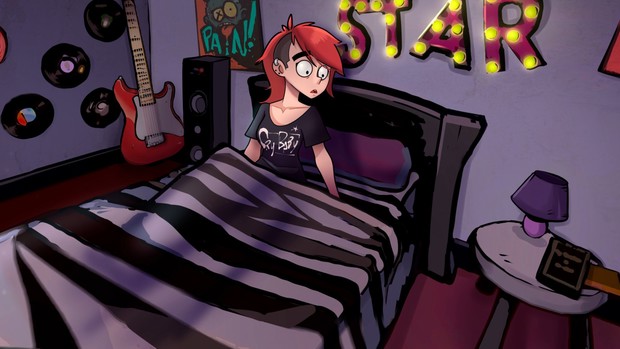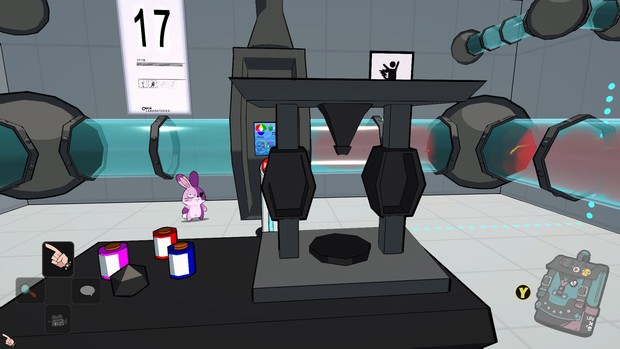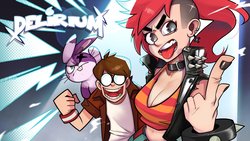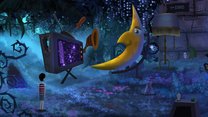Delirium review – Short, raw but frequently funny absurdist adventure you’re bound to cotton to while it lasts

- 0 Comments
The dictionary defines delirium as “a more or less temporary disorder of the mental faculties […] characterized by restlessness, excitement, delusions, hallucinations, etc.” Blackgate Studio’s Delirium is about two kids home alone (sort of), trying to track down a missing cat (kind of), going by the name of Lagsana (at least a third of the time). This node-based, point-and-click-but-operated-with-a-game-controller adventure is unpolished, clunky, and has no real resolution, but still manages to be fairly fun by unabashedly embracing its kooky cast in increasingly improbable situations over the course of one night that suits the title perfectly.
Delirium opens sanely enough, with lead character Lola Torres, a teenage punk girl, asleep in bed with her cat curled up next to her. The bedroom door opens and a woman steps into view, completely silhouetted by the light of the hall behind her. She beckons to the feline, who obediently goes to her, before closing and locking Lola’s door behind her. Startling awake, Lola sets out to escape her room, then journey through a familiar and yet suddenly surreal household in order to rescue her missing pet.
Although Mom and Dad are out for the evening, Lola is hardly alone in the house. Apparently the Torres family spent all their money installing locks inside the house and didn’t have any left over for the exterior, as a bevy of eccentric characters have wandered inside this night, proving to be both hindrances and help in equal measure. There’s Heinnekenn, a magician dressed only in his underwear, a top hat, and a green cooking apron, who has settled into the kitchen because the location makes “the magic flow better.” Then there’s the curmudgeonly Bobby, the house elf, a clear parody of Dobby from the Harry Potter books, who maintains his master’s small abode under the main floor stairway. The garage has been taken over by a mad scientist called Nick Rodriguez, who looks more than a little like Rick from Rick and Morty. Even the original Jumanji movie gets a nod when the Robin Williams-inspired Robbin Parrish materializes from a board game, because why not? In fact, this philosophy sums up much of what’s been thrown against the wall here to see what sticks: why not? No real effort is spent justifying how or why all these characters are here; they’re simply present to have amusing banter with Lola and her coterie of companions.

That’s right, Lola doesn’t have to face this group of weirdos alone. In due course, she is first joined by her livestreaming gamer brother Danny, and later the duo becomes a trio when Danny’s stuffed old one-eyed purple bunny Cotton teams up with them. It’s never explained how Cotton has come to life, or why he’s suffering from a case of the runs when sister and brother first encounter him. Nevertheless, after his bowel condition has been dealt with, thanks to a magic potion from Heinnekenn, the sentient toy rabbit comes along for the ride, mostly to make fun of the siblings and to creepily hit on Lola.
It’s in the dialog banter that Delirium hits its mark. Having a team of characters allows for short, frequent conversations that go back and forth in a pacey manner. The game is unvoiced, with the dialog presented in a visual novel style where a large portrait of the currently speaking character is displayed onscreen, accompanied by text appearing in tickertape fashion. Fortunately, a tap of a button skips the slow text display and jumps straight to the full finished line. While the script maintains a generally humorous tone in its own right, it often gets a little boost due to the awkward and inconsistent localization. Lola’s cat, who is vaguely reminiscent of Garfield in appearance, is called alternately Lagsana, Lagsagna, or Lagsania, when I’m pretty sure the game was going for Lasagna, which I never once saw used. That odd gag must have been intentional (right?), but there are plenty of other examples that are clearly a case of poor translation.
The cast is illustrated in a clean, brightly coloured cartoon fashion with a wide array of expressions, including contemplative, smug, annoyed, ill, shocked, and many more. Each character is infused with a distinctive personality through their respective renderings. For everyone except Lola, whom you control from a first-person perspective and see only during conversation, these models appear both as larger dialog portraits and as paper-thin 2D depictions of the characters in the 3D environment. This can sometimes look a little weird if one of them is placed close to the camera, as their flat nature becomes readily apparent. However, in general the characters integrate well with the 3D sets, which feature a pleasingly vibrant, cel-shaded art style, making them cartoonier in nature.

As the little band of Lola, Danny, and Cotton proceeds through the house, they are faced with puzzles just as eclectic as their visitors. Some are simple, including flipping breakers that add power to the house’s electrical grid without causing an overload, or simply searching the place for inventory items to create a Harry Potter costume for Danny. Others are more involved, like when mixing different potion ingredients while adhering to a series of logical rules to create a diarrhea cure. One puzzle sees the team miniaturized by Nick Rodriguez to enter and repair a crucial battery in a subatomic world that looks suspiciously like a Portal test chamber. This one, which involves the correct mixing of coloured gases, I didn’t so much solve as stumble upon the right answer before I could get a sense of how all the parts worked. Overall there’s nothing earth-shatteringly original about the puzzles on offer, and their difficulty is all over the place instead of steadily ramping up, but they’re fun to solve and even more enjoyable to have the characters comment on. (Lola and Cotton give Danny a good ribbing after Bobby repeatedly calls him master while in the guise of Harry.)
Delirium would have been even better had its PC controls received a bit more tender loving care. Although it’s rendered in real-time 3D, it does not allow for free movement through the environment, or visibly indicate where you can move from where you’re standing. Instead, attempted interactions with things that are too far away will cause Lola to jump between locations in discrete intervals, which also triggers the game’s single progressive autosave. In each node you can look all around in a fashion familiar to anyone who’s played Myst 3, The Journeyman Project 3, or many other first-person adventures of that era. However, those games were controlled solely by the mouse to look, move and interact with hotspots. Here that type of input has been eschewed in favour of a game controller, without even a viable keyboard alternative. One stick allows you to turn in any direction; the other lets you move an onscreen pointer up, down, left, and right. This is where things get really weird.
Positioning the cursor over an interactive object within range highlights it with a purple wireframe outline, but only if you are in the proper interaction mode. For example, some objects only register as hotspots if you have the “use” action selected, while others only highlight if you have the “look” action chosen. Talk is also available, and the three can readily be switched between using the controller’s d-pad. During the optional tutorial, the game does warn you that some things can only be interacted with via specific actions. However, I found the inconsistency as to what was available in what mode to be distracting. Instead of guessing, I started hitting the bumper on my gamepad as soon as I stopped in a new position to highlight all objects in each mode by cycling through the d-pad options. Throw in the fact that some objects only become active when they are deemed to be relevant to the story and I ended up spending more of the game’s two-hour run time than I would have preferred just identifying what I had to work with.
At least that time isn’t spent in complete silence, despite the lack of voices. Synth tunes play in most areas around the house and some of them are quite catchy, such as the Potter-esque theme that starts whenever passing through the first-floor hall where Bobby resides. Sound effects suit the action and even occasionally accompany the dialog. An early exchange between Lola and Danny – a contest of wills – has the characters growling at each other, which is punctuated by audible “grrs,” making the scene even funnier. Then there’s the dip into the miniaturized Portal level, which has a faintly echoing ambience evocative of the game on which it’s based. All told, the soundscape is handled quite well.
Final Verdict
Delirium is as weird a game to assess as it is to play. By rights, its clunky control scheme, weak localization, scattershot puzzle difficulty, and lack of explaining anything at all should make for an underwhelming experience. And yet the frequently funny conversations, expressiveness of the characters, near stream-of-consciousness narrative, and general silliness make for a fun and amusing outing. Its short play time means it doesn’t overstay its welcome, and indeed its offbeat cliffhanger sort of ending left me wanting to spend more time with its protagonists. Hopefully the developers will continue the story and take the opportunity to smooth over the rough patches in the future.
Hot take
It may not be the most polished or user-friendly game, but Delirium’s zany night at home with two teens and a talking stuffed bunny proves to be a fair bit of fun.
Pros
- Character banter is amusing and fun
- Character models are expressive and colourful
- Audio is incorporated well, suiting the different pop culture references being parodied
Cons
- Game controller is required, and interface is slow and clunky
- Hotspots are inconsistent based on actions being attempted
- Only a single progressive autosave
Richard played Delirium on PC using a review code provided by the game's publisher.

- Advertisement
- Help support AGH by advertising with us











0 Comments
Want to join the discussion? Leave a comment as guest, sign in or register.
Leave a comment